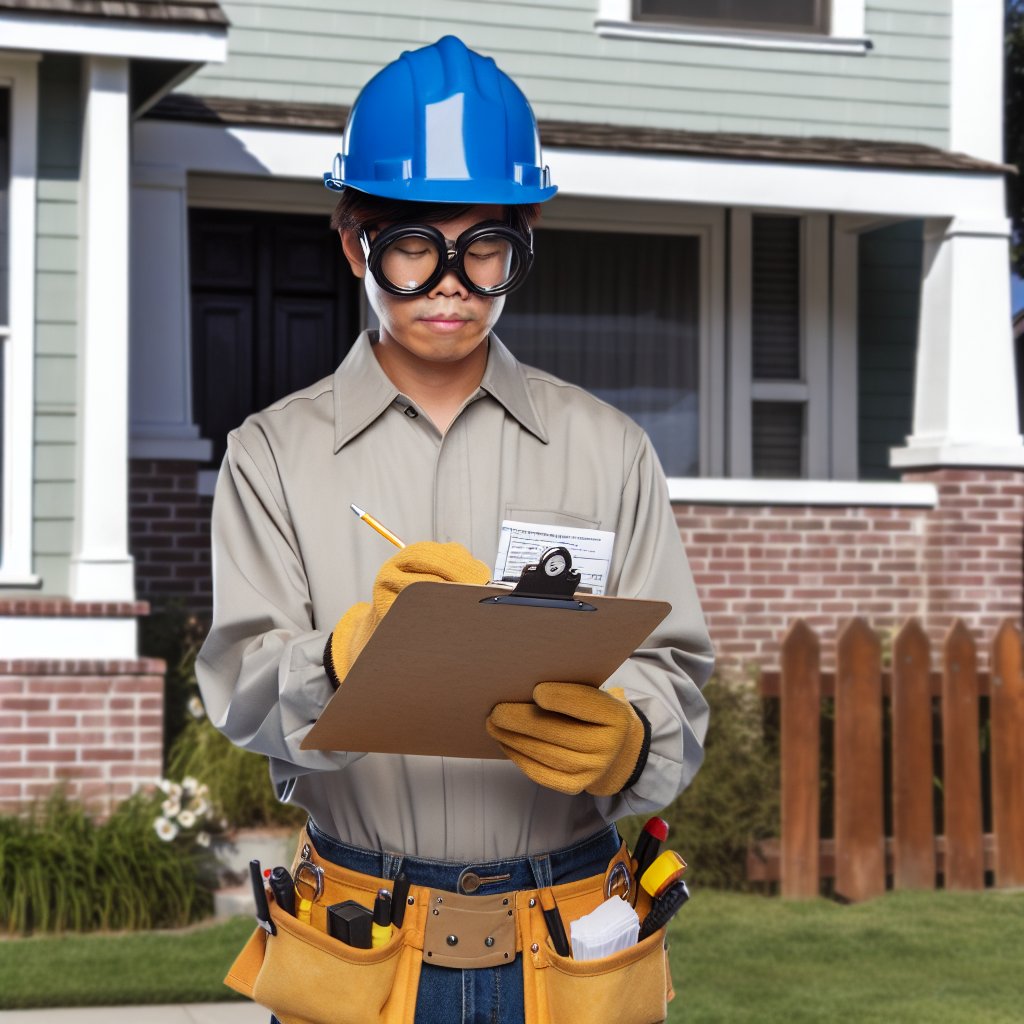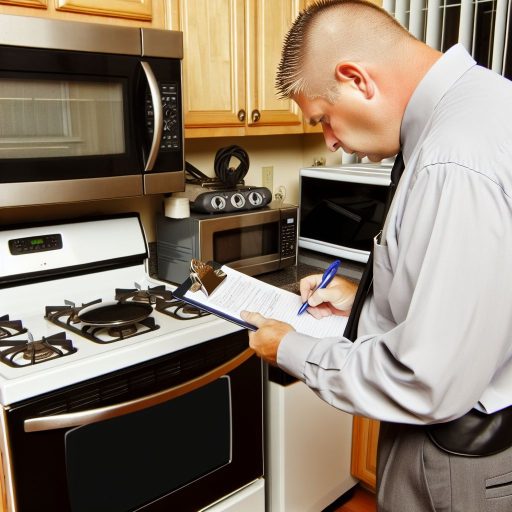Understanding the Importance of a Home Inspection
Protecting Your Investment
A home inspection serves as a vital safeguard for buyers.
It identifies potential issues before the purchase is finalized.
This process protects your investment from unexpected costs.
Moreover, it enhances your negotiating power in the buying process.
Ensuring Safety and Compliance
Home inspections assess safety hazards within the property.
Inspectors look for issues like mold, structural damage, and faulty wiring.
These findings ensure the home complies with local regulations.
Thus, buyers can avoid hazardous living conditions.
Providing Peace of Mind
Buying a home is one of the largest financial decisions you’ll make.
An inspection provides peace of mind about your purchase.
Knowledge of the property’s condition can alleviate buyer’s remorse.
Additionally, it allows for informed decision-making throughout the process.
Identifying Future Costs
Home inspections can highlight upcoming repair needs.
This foresight helps budget for future expenses effectively.
Understanding potential costs aids in maintaining the property’s value.
Consequently, buyers feel more prepared for home ownership.
Negotiation Leverage
An inspection report can be a powerful negotiation tool.
Buyers can request repairs or price reductions based on findings.
It offers a fair basis for discussions with the seller.
Ultimately, this process can lead to a better deal.
Importance of Home Inspections
A thorough home inspection is essential for buyers.
It protects investments, ensures safety, and provides peace of mind.
Make sure to prioritize home inspection during your buying journey.
Key Components of a Home Inspection Checklist
Exterior Elements
The home’s exterior sets the first impression.
Inspect the roof for missing shingles or leaks.
Check the siding for cracks or damage.
Examine windows and doors for proper sealing.
Evaluate the foundation for any visible cracks or shifts.
Interior Rooms
Every room in the house requires attention.
Look at the walls for water stains or mold.
Examine flooring for signs of wear or damage.
Check ceilings for cracks and leaks.
Ensure electrical outlets are functional and safe.
Plumbing Systems
Safe plumbing is crucial for home functionality.
Inspect pipes for leaks or corrosion.
Check the water heater for age and efficiency.
Examine the water pressure in faucets and showers.
Ensure proper drainage in sinks and bathtubs.
HVAC Systems
A well-functioning HVAC keeps homes comfortable.
Check the age and maintenance records of the unit.
Inspect ducts for dust accumulation and blockages.
Ensure thermostats are operational and efficient.
Examine ventilation systems for proper airflow.
Safety Features
Safety is a top priority for any homebuyer.
Inspect smoke detectors and carbon monoxide detectors.
Check for the presence of fire extinguishers.
Ensure stairways have proper handrails.
Examine windows for easy egress in emergencies.
Additional Considerations
Don’t overlook the little details during inspections.
Check for signs of pests, such as rodents or termites.
Examine garage doors for functionality and security.
Assess landscaping for potential drainage issues.
Document any concerns and seek further evaluation if necessary.
Structural Integrity: What to Look For
Foundation Stability
The foundation supports the entire structure.
Inspect for cracks, settling, and movement.
Look for dampness or signs of water damage.
Check for uneven floors, which may indicate issues.
Wall Condition
Walls should be straight and free from cracks.
Examine for signs of bowing or bulging.
Inspect the interior walls for water stains or peeling paint.
Roof Integrity
The roof protects against weather elements.
Check for missing shingles or significant wear.
Inspect the gutters for blockages and leaks.
Look for sagging areas that may indicate structural issues.
Window and Door Frames
Frames should align properly without gaps.
Check for signs of rot or water damage around frames.
Open and close each window and door to ensure functionality.
Inspect seals for signs of deterioration or mold.
Basement and Attic Inspection
The basement should be dry and free of mold.
Search for cracks in the walls and floors.
In the attic, check for proper ventilation and insulation.
Look for signs of pests, such as droppings or nests.
Additional Structural Elements
Examine beams and joists for signs of sagging.
Inspect any visible plumbing and electrical systems.
Look for rust or corrosion on metal structures.
Evaluate the overall condition of the siding materials.
See Related Content: Home Inspection Checklist For Post-Inspection Repairs And Renovations
Electrical Systems: Ensuring Safety and Compliance
Importance of Electrical Systems
Electrical systems are essential for any home.
They power everything from lights to appliances.
Proper inspections can prevent potential hazards.
Understanding electrical systems enhances buyer confidence.
Key Electrical Components to Inspect
First, check the main electrical panel.
Look for rust, signs of overheating, or damage.
Next, inspect the circuit breakers.
Ensure they trip correctly and show no wear.
Also, evaluate the wiring throughout the home.
Wires should not be frayed or exposed.
Verify that the outlets and switches function properly.
Common Electrical Code Violations
Familiarize yourself with common code violations.
These may include improper grounding or overloaded circuits.
Additionally, check for unpermitted wiring changes.
Outdated materials should also raise concerns.
Hiring a Qualified Inspector
Consider hiring a licensed electrical inspector.
They can identify issues that may go unnoticed.
Experience plays a crucial role in thorough inspections.
Always ask for credentials and references.
Maintenance Tips for Homeowners
Regular maintenance can extend the life of electrical systems.
Schedule routine professional inspections.
Replace worn-out components immediately.
Consider installing surge protectors for sensitive devices.
Educate all family members about electrical safety.
Uncover the Details: Top Mistakes First-Time Homebuyers Should Avoid When Purchasing A Home
Plumbing Inspections: Detecting Potential Issues
Importance of Plumbing Inspections
Plumbing inspections protect buyers from costly repairs.
A thorough plumbing inspection identifies hidden issues early.
It ensures the home’s plumbing system operates efficiently.
Moreover, it guarantees compliance with local building codes.
Key Areas to Inspect
Inspecting the drainage system is crucial.
Look for signs of clogs or slow drainage.
Check all water supply lines for leaks.
Also, examine faucets and showerheads for functionality.
Review the water heater for age and maintenance records.
Identifying Common Plumbing Issues
Leaky pipes can cause significant water damage.
Finding corrosion on pipes indicates potential failure.
Additionally, check for uneven water pressure in faucets.
Do not overlook the state of the sump pump in basements.
Using Professional Inspectors
Hiring a licensed plumber offers peace of mind.
Professionals have the expertise to spot hidden problems.
They can provide a detailed report on the plumbing system.
Furthermore, a thorough inspection may save money in the long run.
Delve into the Subject: Understanding Closing Costs and Their Role in Homebuying
Roofing: Identifying Signs of Wear and Damage
Understanding Common Roofing Materials
Different roofing materials have unique lifespans and care requirements.
Asphalt shingles are popular but can wear out quickly in harsh weather.
Metal roofing offers longevity and resistance to deterioration.
Tile roofs provide aesthetic appeal but require proper support structures.
Inspecting for Visible Damage
Start by inspecting the roof’s surface for missing or broken shingles.
Look for curling, buckling, or lifting shingles that indicate age and damage.
Check for any visible holes or punctures that might lead to leaks.
Additionally, observe the metal flashing around chimneys and vents.
Corroded or damaged flashing can allow water infiltration.
Examining the Roof’s Structure
Look closely at the roof’s structure from the attic or interior space.
Check for signs of sagging or unevenness in the rafters and decking.
These issues often signal underlying structural problems that need addressing.
Verify that the insulation is dry and that there are no moisture stains.
Monitoring for Algae and Moss Growth
Check the roof for algae or moss growth, particularly on shaded areas.
This growth can trap moisture and lead to damage over time.
Consider cleaning techniques that remove growth without harming the shingles.
In some cases, applying protective coatings can prevent regrowth.
Assessing the Gutter System
Look at the condition of the gutters and downspouts during the inspection.
Ensure gutters are not clogged with debris, which can lead to overflow.
Check that gutters are securely fastened to the roofline.
Examine the drainage system to ensure it directs water away from the foundation.
Seeking Professional Help
If you identify significant damage, consider hiring a roofing contractor.
A qualified professional can provide a comprehensive assessment.
They can offer recommendations for repairs or replacements based on findings.
Trust their expertise to help protect your home and investment.
You Might Also Like: Home Inspection Checklist For Understanding Local Building Codes

HVAC Systems: Evaluating Efficiency and Condition
Understanding HVAC Systems
The HVAC system plays a crucial role in any home.
It regulates heating, ventilation, and air conditioning.
Efficient HVAC systems enhance comfort and reduce energy costs.
Importance of System Inspection
An inspection of the HVAC system is vital before buying a house.
It helps identify potential issues that could affect comfort.
Moreover, it prevents unexpected repair costs in the future.
Checking for Efficiency
Efficiency ratings indicate how well an HVAC system operates.
It is essential to check the SEER rating for air conditioners.
A higher SEER rating means better energy efficiency.
Also, assess the AFUE rating for heating systems.
This rating measures how efficiently fuel is converted into heat.
Inspecting Physical Condition
Examine the physical components of the HVAC system.
Inspect air filters for dirt and debris buildup.
Dirty filters can hinder performance and efficiency.
Look at the ductwork for leaks or damage.
Leaks can lead to significant energy loss.
Evaluating Maintenance History
A well-documented maintenance history is essential.
Regular maintenance ensures the system runs efficiently.
Check if the system has been serviced regularly by a qualified technician.
This information can provide insights into future performance.
Assessing Age of the System
The age of the HVAC system may impact its reliability.
Most HVAC systems last around 15-20 years.
Consider replacement if the system is nearing the end of its lifespan.
Thorough Evaluations and Inspections
Thorough HVAC inspections protect buyers’ interests effectively.
Ultimately, understanding the efficiency and condition ensures a wise investment.
Exterior and Interior Elements: Assessing Overall Condition
Exterior Elements
Begin by examining the exterior of the property.
The roof should show no signs of damage.
Check the gutters for blockages or rust.
Inspect walls for cracks or water stains.
Pay attention to door and window seals.
Look for signs of pests around the foundation.
The driveway and walkways should be even and well maintained.
Yard drainage must function correctly to prevent flooding.
Interior Elements
Move inside to inspect the main living areas.
Start with the ceilings; they should be free of stains.
Walls should also be intact, with no cracks or peeling paint.
Examine floors for any signs of wear or damage.
Ensure that doors and windows open and close smoothly.
Check light switches and outlets for functionality.
Inspect heating and cooling systems for efficiency.
Kitchen Area
The kitchen is a focal point in any home.
Inspect appliances to ensure they are operational.
Check cabinets for water damage or misalignment.
Look at the countertops for scratches or stains.
Ensure the plumbing under the sink is leak-free.
Bathroom Inspection
The bathrooms must be thoroughly examined for issues.
Check for mold around bath fixtures and tiles.
Inspect tubs, showers, and sinks for cracks or leaks.
Ensure that toilets function correctly and are secure.
Examine exhaust fans for proper operation.
Attic and Basement
Don’t forget the attic and basement during your inspection.
Check the attic for insulation and ventilation issues.
Inspect for any signs of water damage or pests.
Look for cracks in the basement walls or floor.
Ensure the sump pump works if there is one.
Final Walk-Through
Complete your inspection with a final walk-through.
Take notes on any issues you find for future reference.
Review safety features like smoke detectors and fire extinguishers.
Consider scheduling repairs or further assessments as needed.
The Role of Professional Inspectors vs. DIY Inspections
Understanding Professional Inspections
Professional home inspectors bring extensive training and experience.
They systematically evaluate properties to uncover potential issues.
Furthermore, they often use specialized tools for thorough assessments.
These inspectors follow established guidelines, ensuring accuracy.
Thus, buyers can trust their feedback on the property’s condition.
The Value of Experience
Experience enhances an inspector’s ability to identify problems.
Professional inspectors regularly complete continuing education courses.
Therefore, they remain updated on building codes and regulations.
Additionally, their expertise allows them to foresee future maintenance needs.
Advantages of Hiring Professionals
Hiring a professional can save buyers time and money.
They can spot issues that the average person might overlook.
Moreover, a professional inspection report strengthens your negotiating position.
This documentation is crucial for making informed purchase decisions.
Limitations of DIY Inspections
DIY inspections often lack the thoroughness of professional assessments.
Homeowners may miss critical issues due to inexperience.
As a result, small problems may escalate into significant repairs.
Moreover, DIY efforts can lead to misplaced confidence in a property.
When to Choose DIY
DIY inspections can work in home maintenance situations.
For example, homeowners may check for routine maintenance needs.
These can include assessing gutters, filters, or landscaping.
However, it is wise to consult professionals before buying a new home.
Making an Informed Decision
Understanding the differences between professional and DIY inspections is crucial.
Buyers should weigh their comfort level with home maintenance.
Ultimately, investing in a professional inspection can avert future headaches.
A professional inspector provides peace of mind for buyers.
Post-Inspection Actions: How to Use the Findings
Prioritizing Repairs
Begin by reviewing the inspection report thoroughly.
Identify critical issues that require immediate attention.
Focus on safety concerns such as electrical or structural problems.
Next, prioritize minor repairs that can enhance home value.
Determine which repairs should be done before moving in.
Budgeting for Repairs
Estimate the costs associated with each identified issue.
Gather quotes from local contractors for necessary repairs.
Consider setting aside a contingency budget for unexpected expenses.
Evaluate financing options if repairs are extensive.
Negotiating with the Seller
Use inspection findings to negotiate repairs or credits with the seller.
Present the report to justify your requests.
Be prepared for negotiations around repair costs.
Keep communication professional and reasonable.
Planning for Future Maintenance
Use the inspection report as a reference for future upkeep.
Develop a home maintenance schedule based on inspection findings.
Keep an eye on areas noted as needing attention in the future.
Consider annual professional inspections to catch issues early.
Documenting Communication
Document all communications related to the inspection results.
Keep copies of the inspection report and any agreements made.
Maintain records of all repairs and maintenance performed.
This documentation may be useful for future real estate transactions.
Additional Resources
Home inspection checklist: What do home inspectors look for?
Phil Murphy Governor Tahesha Way Lt. Governor Justin Zimmerman …




